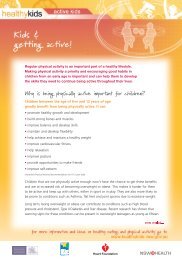I Move We Move - Good For Kids - NSW Government
I Move We Move - Good For Kids - NSW Government
I Move We Move - Good For Kids - NSW Government
You also want an ePaper? Increase the reach of your titles
YUMPU automatically turns print PDFs into web optimized ePapers that Google loves.
Developmental appropriateness<br />
To ensure that opportunities for children to be physically active and acquire movement skills are<br />
developmentally appropriate, consideration need to be given to the age of the child, their cultural<br />
background and also the appropriateness of your guidance or instruction 2 .<br />
Age appropriate<br />
As is the case for other learning areas in early childhood education, physical activity and movement<br />
skills should be considered according to the children’s age 2 .<br />
Babies (birth to 1 year of age)<br />
Babies should be encouraged to be as active as possible in a safe, supervised, minimally structured<br />
and nurturing play environment. <strong>For</strong> younger babies; who haven't yet learnt how to roll or crawl,<br />
physical activity can be encouraged via independent movements such as reaching and grasping,<br />
pulling and pushing, movement of their head, body and limbs during daily routines, and participation<br />
in supervised floor-play, including tummy time 6 . As babies learn to control their neck and head first,<br />
tummy time is important as it gives baby the opportunity to explore and strengthen what their<br />
bodies can do 15,17 .<br />
Being gently moved through space or watching stimuli that are in motion activates their senses and<br />
helps them learn about movement 15 . Examples include baby watching bubbles in the air or being laid<br />
across an adult's lap and held as the adult slowly moves their legs to move baby in various directions 15,18 .<br />
Once a baby is mobile, the type of physical activity expands to include creeping and crawling. Creeping<br />
and crawling are movements where baby crosses the midline of the body. This is where an eye, hand<br />
or foot of one side of the body is used in the space of the other eye, hand or foot. It encourages<br />
brain development through communication between the two hemispheres of the brain 15,17 .<br />
Adult guided developmental movement activities for babies will mostly be one on one interactions<br />
e.g. as a focus child experience or during care giving. However, for babies that are crawling, the<br />
room could be set-up to encourage and extend them to move and explore. <strong>For</strong> example place<br />
cushions, toys and/or chairs around their room for babies to crawl over, around, through or under.<br />
Toddlers and preschoolers<br />
Children aged 1 to 5 years old should be physically active every day for at least three hours in short<br />
bursts spread throughout the day6 . How much time children spend being physically active at their<br />
early childhood service will depend on the unique characteristics of the children, families, staff and the<br />
context in which your service operates (e.g. number of daylight hours children are in attendance).<br />
Physical activity for these age groups should occur primarily through physically active play but<br />
also as part of games, transportation, leisure, and planned activities6. Adult guided fundamental<br />
movement skills learning experiences could involve participation by children in large groups, small<br />
groups, pairs or as an individual activity.<br />
<strong>For</strong> toddlers (1 to 3 years of age) learning to cross the midline of the body is extended from crawling<br />
to walking and climbing stairs, and some initial exploration of throwing, catching, striking and<br />
kicking of balls is appropriate.<br />
<strong>For</strong> preschoolers (3 to 5 years of age) eye-hand and eye-foot movements such as throwing,<br />
catching and kicking balls which involve crossing the midline are further developed in this age<br />
group, as well as locomotor skills such as hopping, jumping and skipping. Exploring these and<br />
other fundamental movement skills continues to enhance brain development.<br />
<strong>For</strong> more information and ideas see Sections Four and Five of The Guide<br />
and The Physical Activity Handbooks.<br />
I <strong>Move</strong> <strong>We</strong> <strong>Move</strong>, The Guide Edition 1 August 2009<br />
AREA HEALTH SERVICE<br />
3.2




